Productivity formula in Excel, it is often said that the efficiency with which inputs are converted into outputs is paramount. Many industries use this as a crucial performance measure to assess effectiveness and efficiency. Depending on the metric you want to measure, Excel provides various formulas for productivity calculation.
Topics covered:
- What is Productivity in Excel?
- Some Factors Affecting Productivity.
- How to use the Productivity formula in Excel? (Example-1, Team’s Productivity)
- How to use the Productivity formula in Excel? (Example-2, Company’s Productivity)
- How to use the Productivity formula in Excel? (Example-3, New Employees Productivity)
- How to use the Productivity formula in Excel? (Example-4, Classroom Teaching Productivity)
- How to use the Productivity formula in Excel? (Example-5, Agricultural Productivity)
- Importance of Productivity.
1. What is Productivity?
Efficiency is the measure of a person’s (or plant/system/organization) productivity in terms of how they convert input to useful output. Economic performance is closely linked to this indicator, which frequently assesses the effectiveness of resource utilization in the production process. Productivity can be expressed in different ways depending on the context and the specific inputs and outputs being measured. Productivity is a vital indicator of efficiency, which has an impact on economic performance at all levels, from individual firms to the economy as scalability. Businesses can become more competitive, more profitable, and sustainable, all while benefiting from better understanding the needs of workers and maximizing productivity.
-
Some Factors Affecting Productivity.
- Technology: Technological progress can lead to improved productivity, as processes become more automated and production is more efficient.
- Skill Level: The ability of workers to perform tasks is influenced by their education and skill level.
- Management Practices: Efficiency can be enhanced by streamlining processes and improving worker motivation through effective management and organizational practices.
- Capital investment: Investment in modern machinery, equipment and infrastructure can improve productivity.
- Working environment: Workers can enhance their efficiency and productivity by working in a secure, healthy environment.
-
How to use the Productivity formula in Excel? (Example-1, Team’s Productivity)
Step 1: Let’s say you have a team of Ten employees who complete 30 tasks in a week.
This week, the team has completed 250 hours of work. Create a data table with the above information.

Step 2: Add the column in A3 and B3 to get the Team’s Productivity result there.

Step 3: Here you can refer to the Productivity formula. You have to use the formula in B3 to get the Productivity result. The formula is: Productivity = Output/Input or =B2/A2
Here the formula applied as you can see below.

Step 4: In the end, hit enter to get the value.
Here you can see below the team’s productivity task is 0.12 per hour.

-
How to use Productivity formula in Excel? (Example-2, Company’s Productivity)
Step 1: Create a data table with the information below. Given,
Output=2,50,000 units
Number of Labors=30
Number of Months=4
Number of Working Days Per Month= 25
Number of Working Hours Per Day=10

Step 2: Now, add another column in A7, B7 to get the total man-hours and A8, B8 to get the Company’s Productivity there.
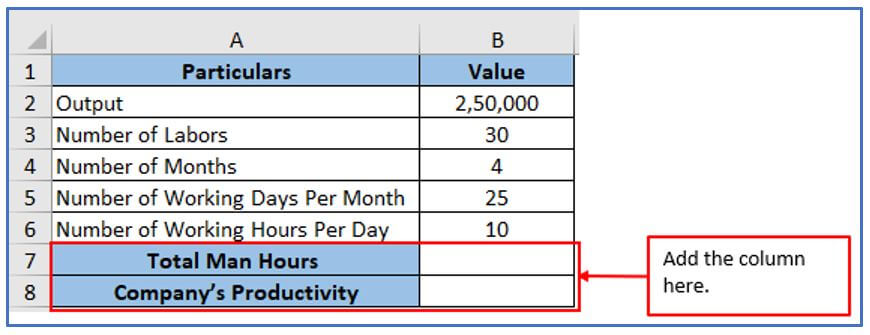
Step 3: First you need to calculate the total man-hours as Input. For calculating the total man-hours, you can use the following formula:
Man Hours (Input) = Number of Workers × Number of Months × Number of Working Days per Month × Number of Working Hours per Day or =B3*B4*B5*B6
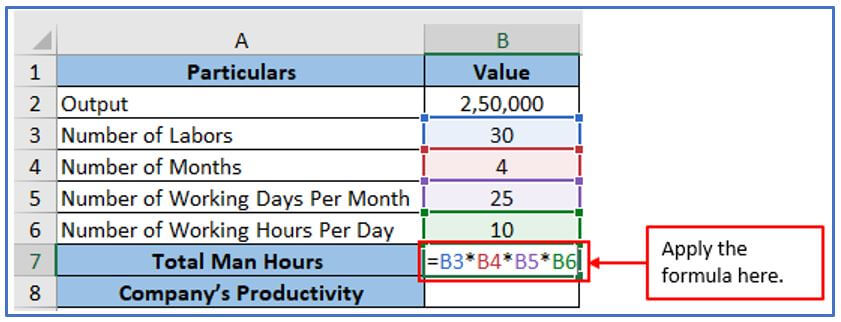
Step 4: Now, press enter to get the total man-hours.
Here is the output of total man-hours.
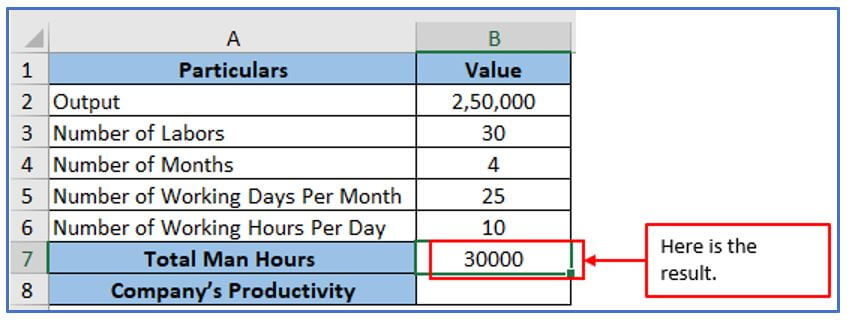
Step 5: Now use the following formula to get the Company’s Productivity. The formula: Productivity =2,50,000 units/30,000 hours or =B2/B7
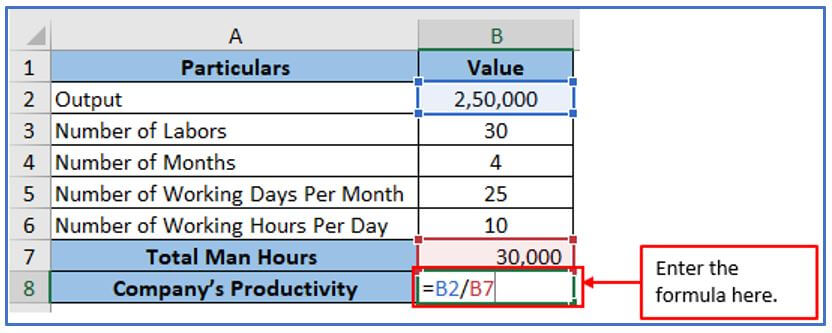
Step 6: Now, press enter to get the value.
Here is the Company’s Productivity result below. Accordingly, the production of employees is 8.33 hours/units.
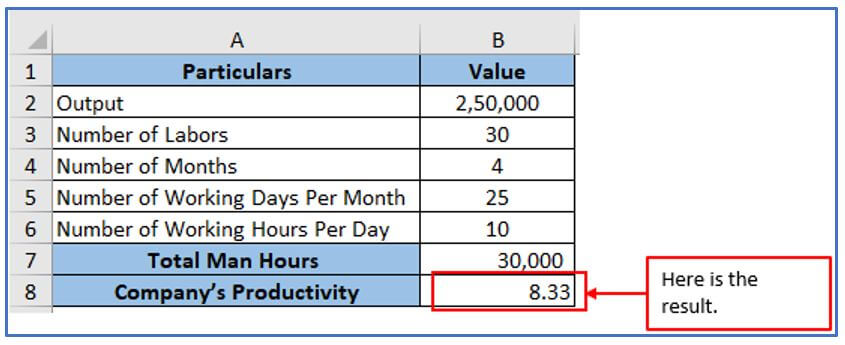
- How to use Productivity formula in Excel? (Example-3, New Employees Productivity)
Step 1: Let’s say the team leader of a financial services firm wants to check how well two recently hired financial analysts Akash and Cummins are doing. By analyzing the number of months each analyst has worked for the firm and the number of cases they have resolved, he measures productivity. Create a data table first with the information below.
Placed the information here.

Step 2: Here you need to add the columns from to get the New Employees Productivity there.
The columns have been added here.

Step 3: Now use the formula in columns B4 and C4 according to the column range to get the New Employees Productivity there. The formula: Productivity = No. Of Cases Executed / No. of Months Served
For, Akash the formula will be: =B3/B2
For, Cummins the formula will be: =C3/C2

Step 4: Now, press enter tab.
According to the analysis presented below, Akash has a case rate of 2.2 per month, Cummins has a case rate of 3 per month and Cummins is considered the most productive analyst.

- How to use the Productivity formula in Excel? (Example-4, Classroom Teaching Productivity)
Step 1: Here the curriculum is overseen by teachers, who contribute 700 hours of instruction to 50 students during the school year and help them reach their learning objectives. Enter the data into your Excel sheet as shown below.
Inputted the information here you can see below.

Step 2: Add the column in A3 and B3 to get the output here.
Follow the below instructions:

Step 3: Here is the formula. Productivity = No. of Students/ Total Hours or 50 students/700 hours or =B2/A2
Applied the formula here.

Step 4: After using the formula press enter and you will get the result of Classroom Teaching Productivity.
The teacher’s productivity is estimated to be about 14 students per hour of lesson.

- How to use the Productivity formula in Excel? (Example-5, Agricultural Productivity)
Step 1: Every year a farmer plows wheat from one field to harvest (3,000 kg) of crops.
The season’s fieldwork hours add up to 450 hours.
Make a table with the above information.
All the details have been placed in the table below.

Step 2: Add the columns in A3 and B3 to get the output there.

Step 3: Use the formula to get the Agricultural Productivity of this farmer. The formula: Productivity = No. of Harvested Wheat / No. of Total Labor Hours
= 3,000 kg/450hours or =B2/A2

Step 4: After entering the formula click on enter then you will get the result.
The Agricultural Productivity is 6.67 kg per hour.

- Importance of Productivity.
- Economic Growth: Productivity is correlated with more efficient production processes, leading to higher living standards and economic advancement.
- Competitiveness: Competitiveness in the market is boosted by organizations that are highly productive and can produce goods at lower prices.
- Resource Optimization: Organizations can identify inefficient areas and use their resources more efficiently by measuring productivity.
Performance Metrics: Managers can gain insight into operational performance by analyzing productivity metrics. This is crucial for business success.
You may be interested:
